Demolition Contractors Charter Oak
Top Demo Contractors in Charter Oak
Receive multiple Demolition Contractors quotes for your project today! Compare profiles, reviews, accreditations, portfolio, etc... and choose the best deal.

Geobear Foundation Repair
536 reviews22603 La Palma Suite 302, Yorba Linda, 92887, USRepair Your Foundation Issues At Their Source Loose and subsiding soils wreak havoc on foundations, causing cracking, settlement, and sinking slabs. Our geopolymer injection process repairs your compromised soils and restores load-bearing integrity. Learn How Geopolymer Injection Works We repair weak soils using a high density geopolymer that is specifically formulated for supporting foundations and concrete slabs. The geopolymer works by filling the voids present in the soils and underneath the slab, and then compacting it into dense matrix or geopolymer in soil. This process reestablishes the soils weight-bearing capacity and contact to your foundation slab. Precision and Excellence Over 200,000 structures treated worldwide We invented the geopolymer soil stabilization solution over 37 years ago, developing and refining the process that has been saving homes and foundations across the globe. The fact is our proprietary techniques, processes, diligence, and polymers are all built around our experiences, successes, and failures that make sure each and every project is done right. This is why our work is guaranteed for 10 years! What to expect from Geobear? Honesty, Professionalism, and a Hassle Free Experience. In our almost 4 decades of experience and over 200,000 projects, we've learned to make the soil repair process as easy an experience as possible. We help homeowners skip costly and disruptive processes that require excavation, heavy equipment, and weeks to months of installation time. Our geopolymer injection solution is so clean and easy that you don't have to move out and the work can be completed in 1-2 days. This means repairing your problem, completing the project in less time, and major cost savings. So why choose Geobear? Because it's a better way.
- Services
- Why Us?
- Testimonials
- Gallery
Get Quote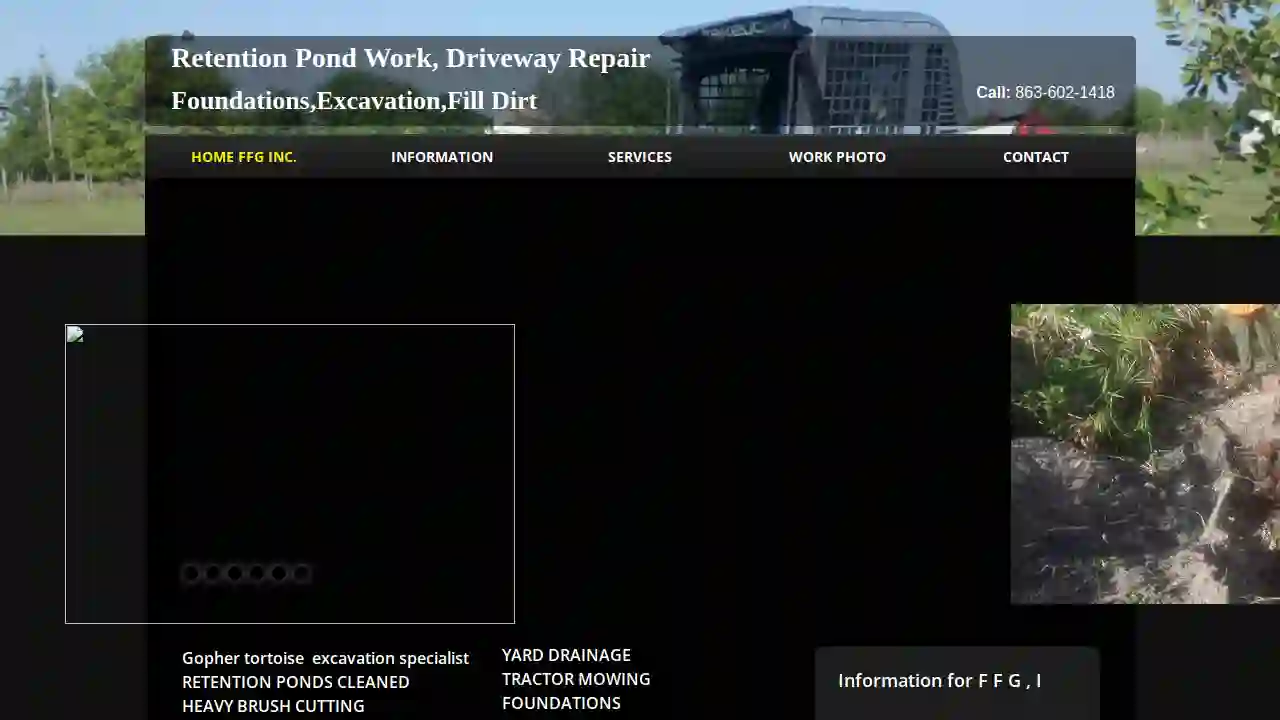
Florida Finish Graders, Inc.
52 reviewsDavis, USFlorida Finish Graders, Inc. Florida Finish Graders, Inc. is located in Central Florida, with Service provided coast to coast. We are your source for central Florida land clearing, grading, excavation, foundations, and bobcat work, tractor work. We here at Florida Finish Graders, Inc. do the best work the first time, and at the most affordable price! Our Mission Helping property manager's take care of their grounds! We provide a variety of services for you. We can put together a plan so that your work site is in compliance with the FDEP from the start, avoiding costly infractions, as Raymond is a Licensed, State Certified Florida storm water erosion and sedimentation Control Inspector. Our Experience Working with the state of Florida, Operating the backhoe according to direction provided by the Project’s Florida Fish and Wildlife Conservation Commission (FWC) Gopher Tortoise Authorized Agent to excavate gopher tortoise. We tear out concrete driveways for complete replacement. Florida driveways can be made with recycled material, such as crushed concrete and asphalt-black top. Tree stump removal, tree stump grinder, large or small, we do it all. F F G Inc., has done many retention ponds or detention pond, new and rebuild to swfwmd standards for recertification, they have certified our work for double the standard time because of the superb work on our retention pond, swale work, grading, sod etc.. Florida Finish Graders, Inc. has sand and fill dirt for your yard, or complete tear out of your grass yard, (sod) and then re-grade your yard, then apply grass. FFG Inc,. can build your home foundation from the ground up or fill in stem wall foundation, building mono slab foundations. We provide sand, fill dirt, recycled material in central Florida. We can level your dirt.
- Services
- Why Us?
- Gallery
Get Quote
Schreiber Excavating
53 reviews1767 Kenyon Road, Ontario, 14519, USSchreiber Excavating has a long history of happy clients across New York State. You can expect only the best in construction, utility installation, and trucking services from Dan and his team. Working at an expert level in construction requires highly trained workers and precision equipment. We use only the most advanced technologies to ensure safety, efficiency, and the best price possible. At Schreiber Excavating, our top priority is client satisfaction. You can expect a job well done—every time. Schreiber Excavating has a proven track record of delivering only the finest quality site work and utility services from initial conception to final product. Our highly trained team places safety first while maintaining a diligent focus throughout the entire process. You can trust Schreiber Excavating to make your construction a reality.
- Services
- Why Us?
- Testimonials
- Gallery
Get Quote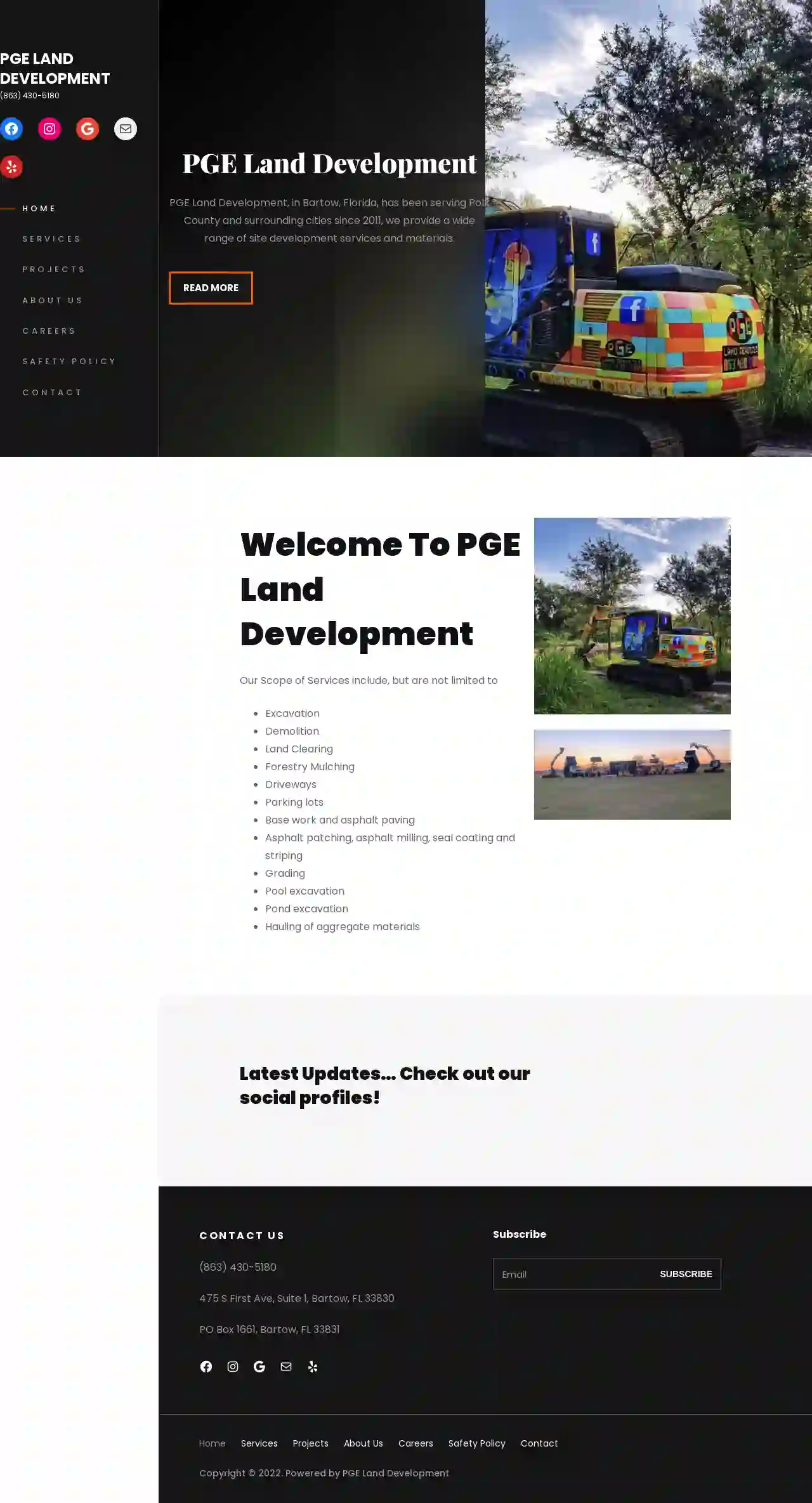
PGE Land Development
4.713 reviews475 S First Ave, Suite 1, Bartow, USPGE Land Development PGE Land Development, based in Bartow, Florida, has been serving Polk County and surrounding areas since 2011. We offer a comprehensive range of site development services and materials. Our founder, Kevin Cutts, grew up in the site development industry, gaining hands-on experience from a young age. His passion for the industry and commitment to continuous learning have driven PGE's growth and evolution. In 2011, Kevin established PGE with the vision of building a legacy for his children. Since then, PGE has helped countless customers bring their dream projects to life. Kevin remains dedicated to providing exceptional customer service and upholding the core values that define PGE.
- Services
- Why Us?
- Our Team
- Gallery
Get Quote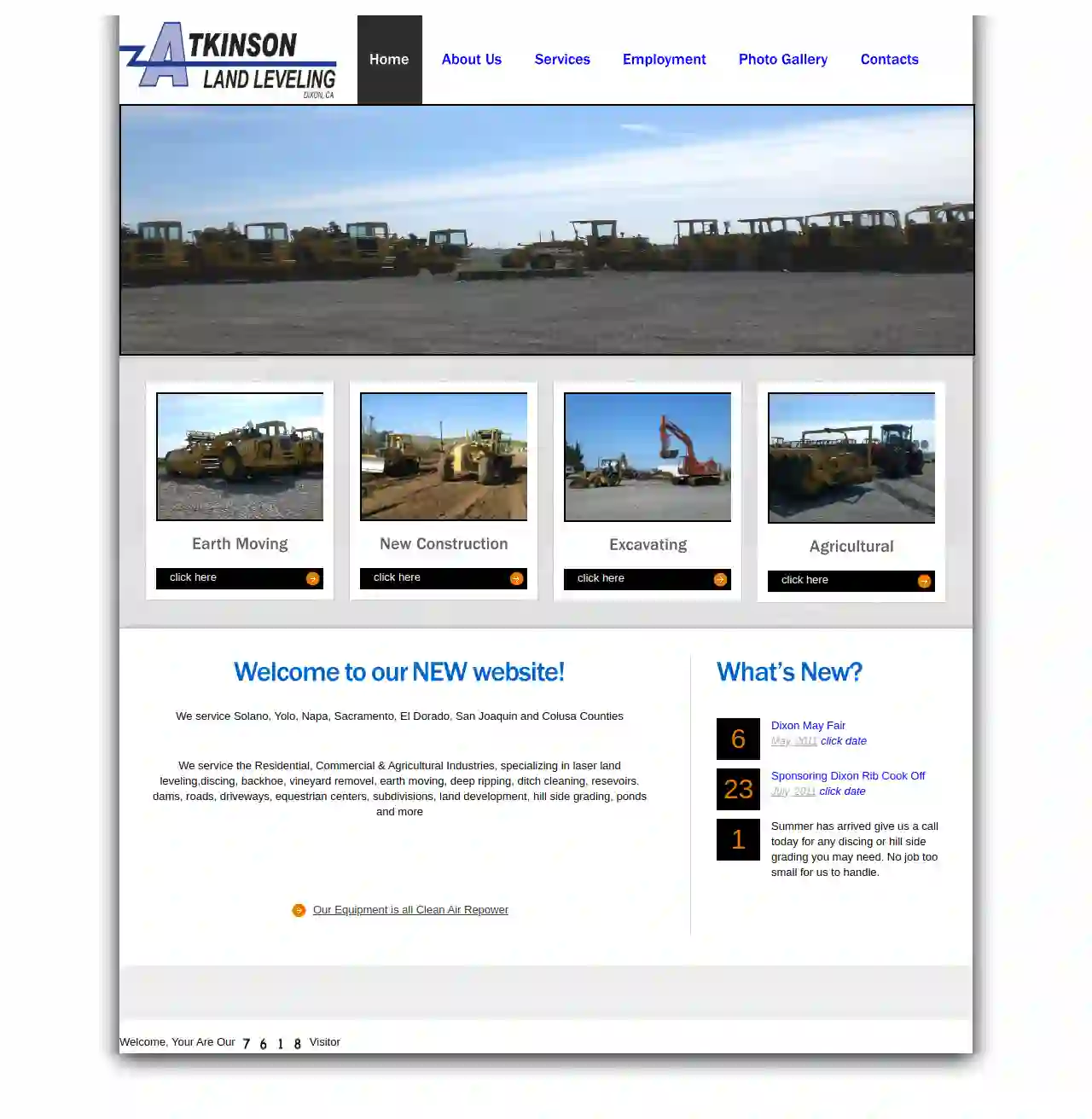
Atkinson Land Leveling
51 reviewsDixon, 95620, USAtkinson Land Leveling: Your Trusted Partner for Land Development Atkinson Land Leveling is a family-owned and operated business serving Solano, Yolo, Napa, Sacramento, El Dorado, San Joaquin, and Colusa Counties. We specialize in a wide range of land development services for residential, commercial, and agricultural clients. Our commitment to quality, efficiency, and customer satisfaction has made us a trusted name in the industry. We understand that every project is unique, and we work closely with our clients to ensure their vision is realized. Our team of experienced professionals utilizes state-of-the-art equipment to deliver exceptional results on every job. Whether you need laser land leveling, excavating, discing, vineyard removal, earth moving, ditch cleaning, or any other land development service, we have the expertise and resources to handle it. At Atkinson Land Leveling, we are dedicated to providing our clients with the highest level of service and support. We are committed to safety, environmental responsibility, and exceeding expectations. Contact us today to discuss your project and learn how we can help you achieve your goals.
- Services
- Why Us?
- Gallery
Get Quote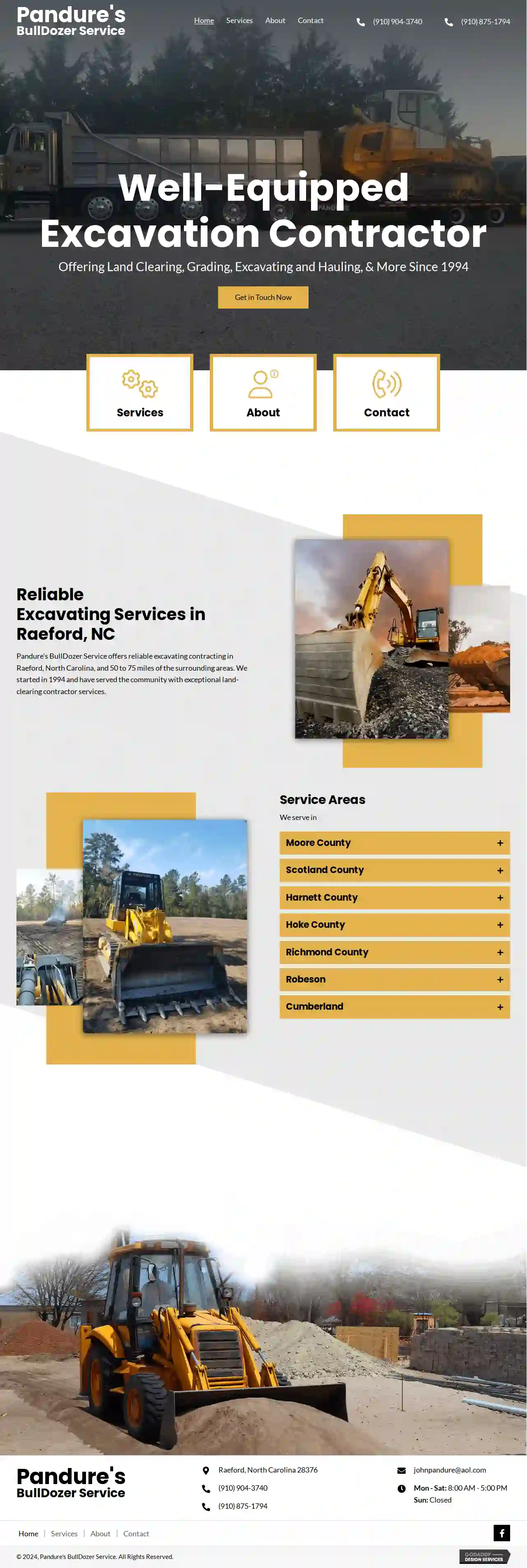
Pandure's BullDozer Service
58 reviewsRaeford, 28376, USPandure's BullDozer Service: Your Trusted Excavation Partner Pandure's BullDozer Service is a family-owned and operated excavation and land clearing specialist based in Raeford, North Carolina. We've been serving the community since 1994, providing reliable and professional services for all your land clearing, grading, excavating, and hauling needs. Our team is comprised of skilled professionals with decades of experience in the industry. We are committed to delivering seamless, safe, and trustworthy services, always prioritizing transparency and working within your budget. Whether you need land leveling for a new construction project, demolition work to clear an existing structure, or expert grading and excavating services, we have the expertise and equipment to handle it all. We are proud to serve a wide range of clients, including builders, developers, and homeowners in Raeford and the surrounding areas. At Pandure's BullDozer Service, we are dedicated to providing exceptional customer service and exceeding your expectations. Contact us today to discuss your project and let us help you bring your vision to life.
- Services
- Why Us?
- Testimonials
- Gallery
Get Quote
The San Jose Excavating Company
58 reviews123 Main Street, San Jose, 95112, USExcavating Contractors San Jose: Your Trusted Partner for Excavation Services At Excavating Contractors San Jose, we are a team of experienced and dedicated professionals committed to providing top-notch excavation services to residential and commercial clients in the San Jose area. We understand that excavation projects require meticulous planning, skilled execution, and a commitment to safety. That's why we leverage our expertise and state-of-the-art equipment to deliver exceptional results that exceed your expectations. Our team is equipped with a wide range of heavy machinery and specialized tools, allowing us to handle projects of any size and complexity. From site preparation and grading to trenching and foundation excavation, we have the skills and resources to get the job done right. We are committed to providing our clients with transparent communication, competitive pricing, and a seamless experience from start to finish. Our goal is to build lasting relationships with our clients by delivering exceptional service and exceeding their expectations. Contact us today to discuss your excavation needs and let us help you bring your project to life.
- Services
- Why Us?
Get Quote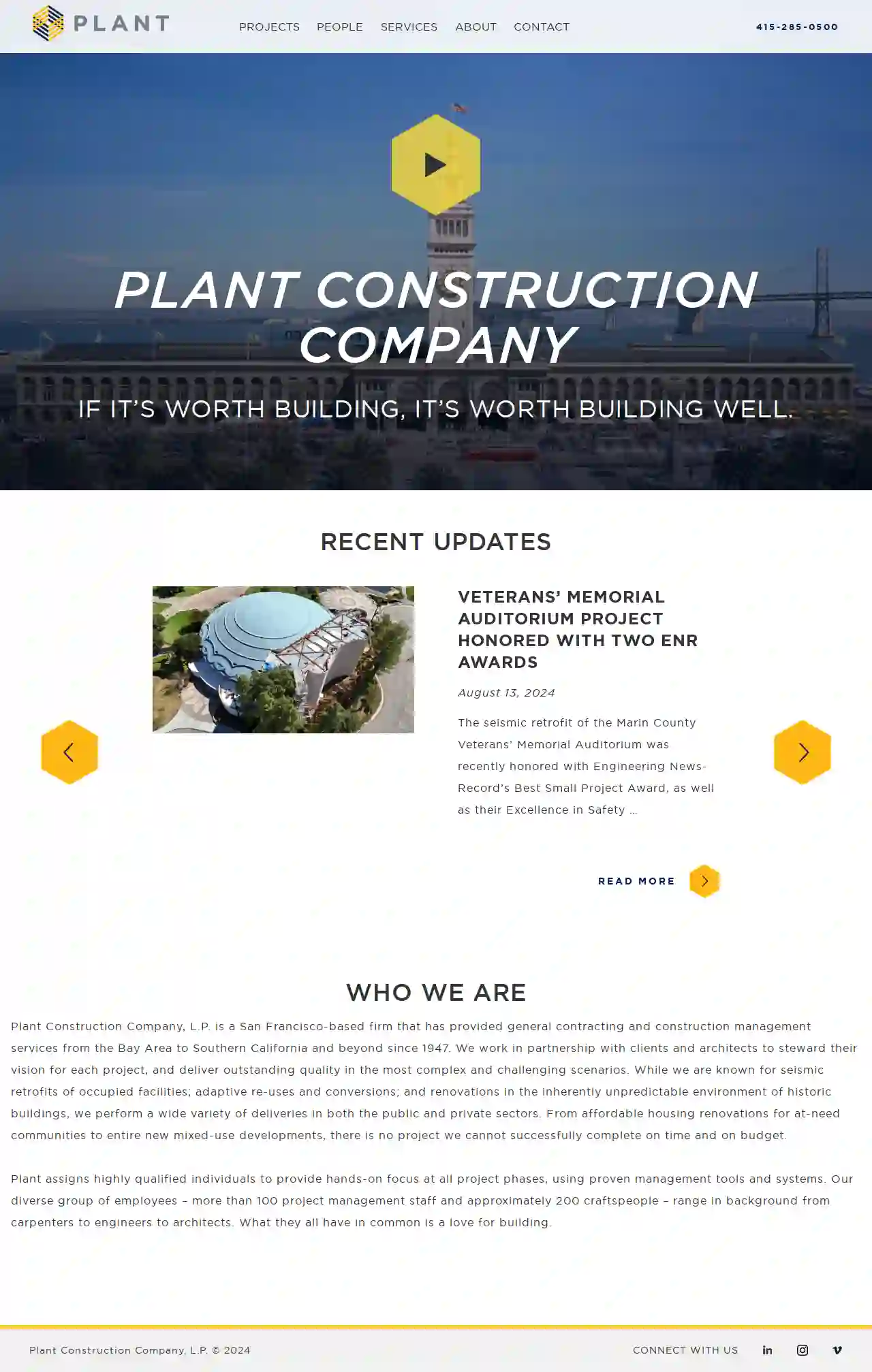
Plant Construction Company, L.P.
4.98 reviewsBrentwood, USPlant Construction Company, L.P. is a San Francisco-based firm that has provided general contracting and construction management services from the Bay Area to Southern California and beyond since 1947. We work in partnership with clients and architects to steward their vision for each project, and deliver outstanding quality in the most complex and challenging scenarios. While we are known for seismic retrofits of occupied facilities; adaptive re-uses and conversions; and renovations in the inherently unpredictable environment of historic buildings, we perform a wide variety of deliveries in both the public and private sectors. From affordable housing renovations for at-need communities to entire new mixed-use developments, there is no project we cannot successfully complete on time and on budget. Plant assigns highly qualified individuals to provide hands-on focus at all project phases, using proven management tools and systems. Our diverse group of employees – more than 100 project management staff and approximately 200 craftspeople – range in background from carpenters to engineers to architects. What they all have in common is a love for building.
- Services
- Why Us?
- Gallery
Get Quote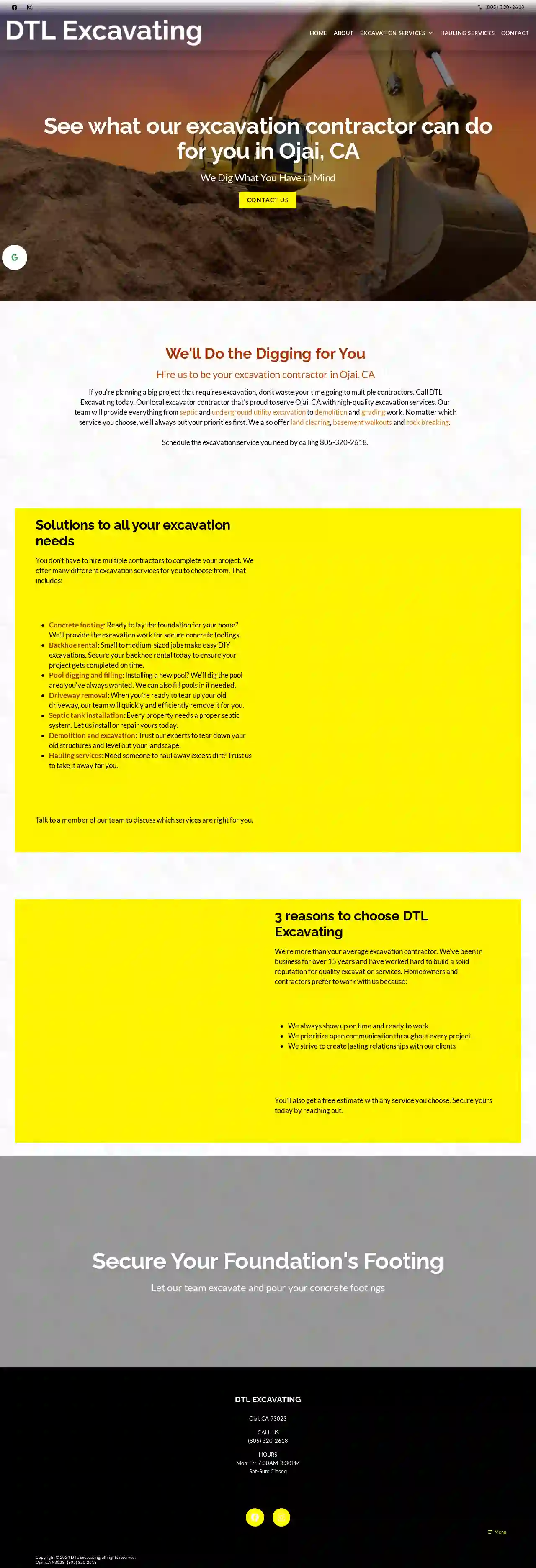
DTL Excavating
52 reviewsOjai, 93023, USWe Dig What You Have in Mind If you're planning a big project that requires excavation, don't waste your time going to multiple contractors. Call DTL Excavating today. Our local excavator contractor that's proud to serve Ojai, CA with high-quality excavation services. Our team will provide everything from septic and underground utility excavation to demolition and grading work. No matter which service you choose, we'll always put your priorities first. We also offer land clearing, basement walkouts and rock breaking. Schedule the excavation service you need by calling 805-320-2618. Solutions to all your excavation needs You don't have to hire multiple contractors to complete your project. We offer many different excavation services for you to choose from. That includes: Concrete footing: Ready to lay the foundation for your home? We'll provide the excavation work for secure concrete footings. Backhoe rental: Small to medium-sized jobs make easy DIY excavations. Secure your backhoe rental today to ensure your project gets completed on time. Pool digging and filling: Installing a new pool? We'll dig the pool area you've always wanted. We can also fill pools in if needed. Driveway removal: When you're ready to tear up your old driveway, our team will quickly and efficiently remove it for you. Septic tank installation: Every property needs a proper septic system. Let us install or repair yours today. Demolition and excavation: Trust our experts to tear down your old structures and level out your landscape. Hauling services: Need someone to haul away excess dirt? Trust us to take it away for you. Talk to a member of our team to discuss which services are right for you. 3 reasons to choose DTL Excavating We're more than your average excavation contractor. We've been in business for over 15 years and have worked hard to build a solid reputation for quality excavation services. Homeowners and contractors prefer to work with us because: We always show up on time and ready to work We prioritize open communication throughout every project We strive to create lasting relationships with our clients You'll also get a free estimate with any service you choose. Secure yours today by reaching out. Secure Your Foundation's Footing Let our team excavate and pour your concrete footings
- Services
- Why Us?
- Gallery
Get Quote
A.P. Thomas Construction, Inc.
52 reviews2330 Butano Drive, Sacramento, 95825, USIt’s a Great Day to Build! With A.P. Thomas Construction, Inc., an award-winning company based in the Sacramento area, you’ll recognize a company that rivals larger firms in capabilities and value, yet gives personal attention and commitment to you and your investment. For more than two decades, we’ve delivered innovation, diversity and quality to commercial projects throughout Northern California.
- Services
- Why Us?
- Gallery
Get Quote
Over 22,076+ Excavation Companies on our platform
Our excavation companies operate in Charter Oak and beyond!
ExcavationHQ has curated and vetted Top Excavation Pros near Charter Oak. Find a trustworthy contractor today.
Frequently Asked Questions About Demolition Contractors
- Enclosure: Sealing off the asbestos-containing material to prevent fiber release.
- Encapsulation: Coating the asbestos-containing material with a sealant to bind the fibers.
- Removal: Carefully removing the asbestos-containing material and disposing of it safely.
- Size and Complexity of the Structure: Larger and more complex structures, such as multi-story buildings, require more time, labor, and specialized equipment, increasing costs.
- Type of Demolition: Different demolition methods, such as implosion, wrecking ball, or high-reach demolition, have varying costs.
- Material Disposal: Disposal fees for demolition debris can contribute significantly to the overall cost, depending on the type and quantity of materials.
- Location and Accessibility: Demolition in densely populated areas or with limited access may require more planning and specialized equipment, affecting costs.
- Hazardous Materials: The presence of asbestos, lead paint, or other hazardous materials requires specialized removal and disposal procedures, adding to the expenses.
How can I tell if my building contains asbestos?
What are the different methods of asbestos abatement?
How much does demolition cost in the USA?
What is a demolition bond?
How can I tell if my building contains asbestos?
What are the different methods of asbestos abatement?
- Enclosure: Sealing off the asbestos-containing material to prevent fiber release.
- Encapsulation: Coating the asbestos-containing material with a sealant to bind the fibers.
- Removal: Carefully removing the asbestos-containing material and disposing of it safely.
How much does demolition cost in the USA?
- Size and Complexity of the Structure: Larger and more complex structures, such as multi-story buildings, require more time, labor, and specialized equipment, increasing costs.
- Type of Demolition: Different demolition methods, such as implosion, wrecking ball, or high-reach demolition, have varying costs.
- Material Disposal: Disposal fees for demolition debris can contribute significantly to the overall cost, depending on the type and quantity of materials.
- Location and Accessibility: Demolition in densely populated areas or with limited access may require more planning and specialized equipment, affecting costs.
- Hazardous Materials: The presence of asbestos, lead paint, or other hazardous materials requires specialized removal and disposal procedures, adding to the expenses.